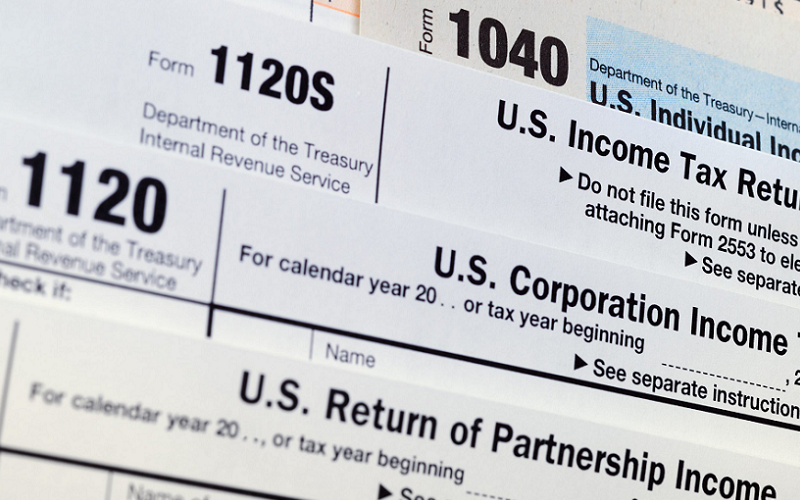
In the complex world of corporate taxation, navigating the labyrinth of C-corporation tax structures can feel like a daunting task. However, understanding the ins and outs of this system is pivotal for business prosperity, ensuring you’re not leaving money on the table come tax time. Here we illuminate the sometimes murky waters of C-Corporation taxation, focusing particularly on tax deductions — those welcome lifelines that can significantly lighten your tax load.
Contents
- Understanding C-Corporation Taxation
- C-Corporation Tax Deductible Expenses
- The Role of Depreciation and Section 179 Deductions
- Utilizing Tax Credits for Your C-Corporation
- Strategic Tax Planning for Your C-Corporation
- References
Understanding C-Corporation Taxation
Before we dig into the specifics of tax deductions for your C-Corporation, it’s essential to lay a solid groundwork by understanding the basics of corporate tax structure. With this knowledge in hand, you will be better equipped to identify opportunities for deductions and streamline your business’s tax efficiency.
Basics of Corporate Tax Structure
In essence, the corporate tax structure in the U.S. operates on a system of brackets, much like individual taxation. As of my knowledge cutoff in September 2021, the federal corporate tax rate for C-Corporations stands at a flat 21%. This rate was established by the Tax Cuts and Jobs Act of 2017, significantly reducing the previous top marginal rate of 35%.
Apart from federal taxes, C-Corporations are also subject to state taxes, which vary depending on the location of the corporation. Some states might also impose a minimum tax and franchise tax.
Distinct Tax Features of C-Corporations
One key aspect that sets C-Corporations apart from other entities like S-Corporations or Limited Liability Companies (LLCs) is how they are taxed. C-Corporations are unique in that they are subject to what’s known as “double taxation.”
The Concept of Double Taxation
The term “double taxation” refers to the way C-Corporations’ earnings are taxed twice—once at the corporate level when earnings are initially generated, and then again at the individual level when these earnings are distributed to shareholders as dividends.
This unique feature of C-Corporations presents both challenges and opportunities. On one hand, double taxation can lead to a higher total tax liability. On the other, C-Corporations can retain earnings (up to certain limits and conditions) and can often provide more flexibility for tax planning strategies—especially for maximizing tax deductions, which is the focus of this guide [1].

C-Corporation Tax Deductible Expenses
Now that we’ve set a solid foundation with an understanding of C-Corporation taxation, let’s get into the heart of the matter—tax-deductible expenses. Identifying and correctly recording tax deductions can greatly reduce your corporation’s tax liability. But first, what exactly are tax deductions? Essentially, they are certain types of expenses that the Internal Revenue Service (IRS) allows businesses to subtract from their income before income tax is applied.
Commonly Overlooked Tax-Deductible Expenses
Many businesses fail to claim all the deductions they’re entitled to, primarily because they’re unaware of their existence. Let’s examine some of these often-overlooked tax-deductible expenses, to ensure your corporation doesn’t miss out on any potential savings.
Office Supplies and Expenses
It might seem obvious, but day-to-day office supplies and expenses often slip under the radar. These can include stationery, software subscriptions, postage, and even coffee for the break room. Keep a record of these purchases as they can add up over time.
Rent and Utilities
If you rent an office space, your monthly payments are tax-deductible. Similarly, utility bills such as electricity, water, and internet are also eligible for deductions.
Employee Wages and Benefits
Salaries, wages, bonuses, and benefits that you pay to your employees are usually tax-deductible. This can also extend to retirement plan contributions and education assistance.
Travel and Entertainment Expenses
Business-related travel and entertainment expenses can often be deducted. This can include travel costs for business trips, meals with clients, and even specific types of local business transportation.
Special Tax Deductions for C-Corporations
Apart from these common deductions, there are also a few special deductions exclusive to C-Corporations that you should be aware of [2].
Domestic Production Activities Deduction
The Domestic Production Activities Deduction, also known as the DPAD or Section 199 deduction, is a special tax break for businesses that produce goods in the U.S. It is designed to incentivize domestic production and can lead to substantial tax savings.
Research and Development (R&D) Deductions
If your corporation is involved in R&D activities, you may be eligible for R&D deductions. This can include costs associated with developing or improving your products or processes.
Qualified Business Income Deduction
While the Qualified Business Income (QBI) deduction is generally associated with pass-through entities like S-Corporations and LLCs, certain C-Corporations, particularly personal service corporations, may qualify for this deduction under specific circumstances.
The Role of Depreciation and Section 179 Deductions
In the realm of tax deductions for C-Corporations, depreciation plays a crucial role in optimizing your tax strategy. By understanding the concept of depreciation and leveraging Section 179 deductions, you can further reduce your taxable income and maximize your corporation’s tax savings.
Understanding Depreciation in Tax Deduction
Depreciation refers to the gradual decrease in the value of assets over time due to wear and tear, obsolescence, or deterioration. From a tax perspective, depreciation allows businesses to deduct the cost of certain assets as an expense over their useful life, rather than claiming the entire cost upfront.
The IRS provides guidelines for determining the useful life of different types of assets, and each asset is assigned a specific depreciation method, such as straight-line depreciation or accelerated depreciation. By spreading out the deduction over several years, depreciation offers significant tax benefits [3].
Benefits of the Section 179 Deduction
Section 179 of the Internal Revenue Code is a provision that allows businesses to deduct the full cost of qualifying assets in the year they are purchased or placed into service, rather than depreciating them over time. This accelerated deduction provides immediate tax relief and can be especially advantageous for C-Corporations looking to lower their taxable income.
The Section 179 deduction has certain limits and restrictions. As of my knowledge cutoff in September 2021, the maximum deduction amount was $1,050,000, with a phase-out threshold of $2,620,000. However, it’s important to note that these limits may be subject to change, so it’s crucial to consult the most up-to-date tax guidelines or seek advice from a tax professional.
Practical Examples of Depreciation and Section 179 Application
To illustrate the benefits of depreciation and Section 179 deductions, let’s consider a hypothetical scenario. Suppose your C-Corporation purchases new office equipment, such as computers and furniture, for a total cost of $50,000.
Without the Section 179 deduction, you would typically depreciate these assets over their useful life, deducting a portion of the cost each year. However, by leveraging the Section 179 provision, you could potentially deduct the entire $50,000 in the year of purchase, significantly reducing your taxable income for that year.
Understanding how to strategically apply depreciation and Section 179 deductions can make a substantial difference in your corporation’s tax liability. However, keep in mind that the rules and regulations surrounding these deductions can be complex, and the specifics may vary based on factors such as asset type, date of acquisition, and your corporation’s financial situation. It’s always recommended to consult with a tax professional to ensure accurate calculation and proper utilization of these deductions.
By leveraging depreciation and Section 179 deductions effectively, you can optimize your tax strategy and maximize your corporation’s tax savings. These deductions, along with other tax planning techniques, can contribute to a more efficient and profitable financial outlook for your C-Corporation.

Utilizing Tax Credits for Your C-Corporation
While tax deductions are valuable in reducing your C-Corporation’s taxable income, tax credits offer a direct reduction in the amount of tax owed. Understanding the difference between deductions and credits and strategically utilizing available tax credits can provide your corporation with significant savings.
The Difference Between Tax Credits and Deductions
Tax deductions lower your taxable income, whereas tax credits directly reduce the amount of tax you owe. In essence, deductions lower the percentage of your income that is subject to tax, while credits provide a dollar-for-dollar reduction in your tax liability.
For example, if you have a $10,000 tax deduction and your corporation falls into the 21% tax bracket, the deduction would reduce your taxable income by $10,000, resulting in $2,100 in tax savings. However, a $10,000 tax credit would directly reduce your tax liability by $10,000, offering more substantial savings [4].
Available Tax Credits for C-Corporations
C-Corporations have access to various tax credits that can significantly reduce their overall tax burden. It’s important to understand the specific eligibility criteria and requirements for each credit. Here are a few commonly available tax credits for C-Corporations:
Research and Development (R&D) Tax Credit
This credit rewards businesses that engage in qualified research activities to develop or improve products, processes, or software. It can provide a substantial credit that incentivizes innovation.
Work Opportunity Tax Credit (WOTC)
The WOTC is designed to encourage employers to hire individuals from targeted groups, such as veterans, long-term unemployed individuals, and recipients of certain public assistance. This credit provides a percentage of wages as a credit, offering an incentive to hire from these groups.
Energy-Efficient Commercial Building Deduction
If your C-Corporation invests in energy-efficient improvements or constructs energy-efficient commercial buildings, you may be eligible for this credit. It encourages businesses to adopt environmentally friendly practices.
The Process of Claiming Tax Credits
To claim tax credits for your C-Corporation, you will typically need to follow these steps:
Determine Eligibility: Review the specific requirements and eligibility criteria for each tax credit to ensure your corporation meets the necessary conditions.
Accurate Recordkeeping
Maintain thorough records and documentation to support your eligibility and the expenses or activities associated with the tax credit. This documentation will be essential in case of an audit.
Complete the Required Forms
Each tax credit has its own associated forms that need to be filled out accurately. These forms typically require detailed information about your corporation’s activities, expenses, and calculations related to the credit.
Complete the Required Forms
Complete the Required Forms: Include the appropriate forms and documentation when filing your corporation’s tax return. Ensure that all relevant information is provided accurately and completely.
As tax credits can significantly impact your corporation’s tax liability, it is advisable to work with a tax professional who specializes in corporate taxes. They can guide you through the process, help identify applicable tax credits, and ensure proper documentation and compliance with IRS regulations.

Strategic Tax Planning for Your C-Corporation
Tax planning is an essential aspect of managing your C-Corporation’s finances effectively. By implementing strategic tax planning techniques, you can optimize your corporation’s tax position, minimize liabilities, and maximize profits.
The Importance of Year-Round Tax Planning
Tax planning shouldn’t be confined to the months leading up to the tax filing deadline. To truly maximize your corporation’s tax savings, it’s crucial to adopt a year-round approach to tax planning. By regularly reviewing your financial situation, staying updated on tax laws and regulations, and proactively identifying opportunities for deductions and credits, you can strategically position your corporation for tax efficiency [5].
Strategic Planning for Capital Gains and Losses
Capital gains and losses can significantly impact your corporation’s tax liability. Strategic planning involves analyzing the timing of asset sales or acquisitions to optimize your capital gains and losses. By strategically offsetting capital gains with capital losses, you can potentially minimize your corporation’s taxable income and overall tax liability.
Effective Use of Carryovers
Carryover provisions allow you to utilize tax benefits from previous years to offset your current tax liability. For example, if your corporation has net operating losses (NOLs) from previous years, you may be able to carry them forward and apply them against current or future taxable income. Additionally, certain tax credits or deductions may have limitations that can be carried forward to future years. By understanding and effectively utilizing carryovers, you can maximize the value of these tax benefits.
Planning for Tax-efficient Profit Distributions
As a C-Corporation, profit distributions to shareholders may be subject to double taxation. However, strategic planning can help minimize the impact of this double taxation. By carefully managing your corporation’s profits and distributions, you can potentially reduce the overall tax burden on your shareholders. Strategies such as reinvesting profits back into the business, implementing employee benefit plans, or exploring alternative structures like employee stock ownership plans (ESOPs) can provide tax advantages while incentivizing employee retention and business growth.
Strategic tax planning requires a deep understanding of your corporation’s financial situation, tax laws, and industry-specific considerations. It is highly recommended to work with a qualified tax professional who can provide personalized guidance tailored to your C-Corporation’s needs. They can help you identify tax planning opportunities, ensure compliance with tax regulations, and implement effective strategies to minimize your corporation’s tax liability.
References
[1] C Corp Tax Deductions: Everything You Need to Know
[2] The Top Tax Deductions for Your Small Business
[3] Tax Deductible Business Expenses
[4] C Corporations
[5] C Corporation
